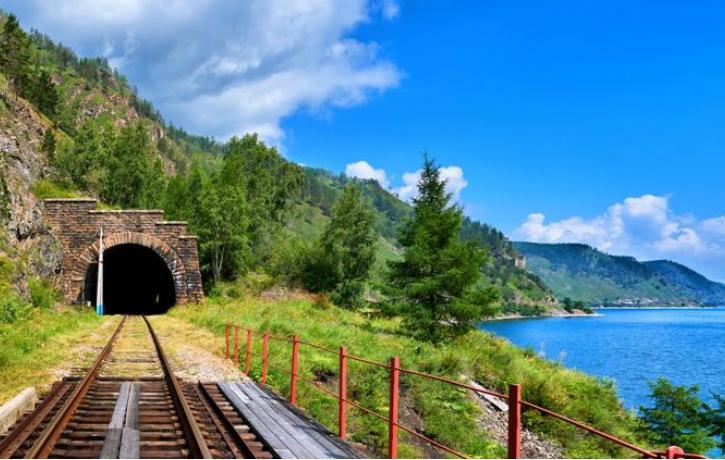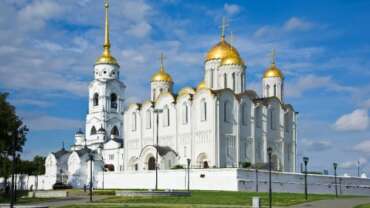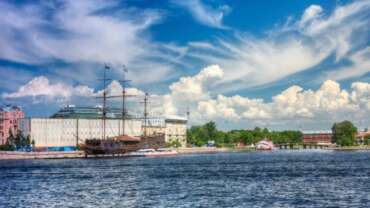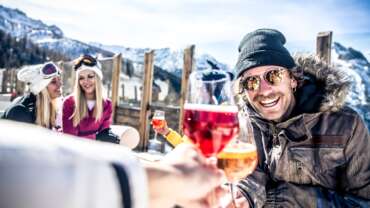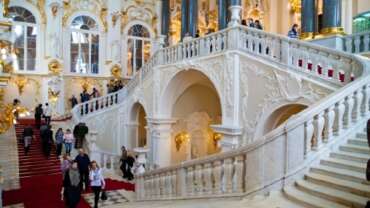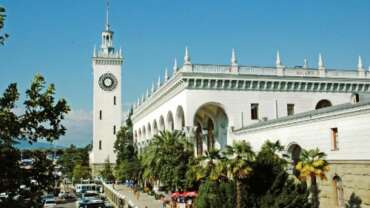Nature in Russia
Baikal Lake – Baikal is the deepest lake in the whole world and it’s located in the southern part of the Eastern Siberia — the region in the Asian part of Russia. It is located at the very border between the Irkutsk region (Irkutskaya Oblast) and the Republic of Buryatiya and has a shape of a giant half-moon. Besides, it’s the biggest reservoir of fresh water on Earth, and the depth of Baikal is 1,167 meters lower the World ocean level. Its maximum depth is 1,642 meters which was learnt in 1983. The square of the Baikal water surface equals to the size of such European countries as, for example, the Netherlands or Belgium. Baikal is ranked number seven in the top of the biggest world’s lakes. Besides, plants which grow there, are rare and endemic, and there are a lot of their kinds, so Lake Baikal even surpasses the Galapagos Islands and Madagascar in it.
Baikal is a sacred place for those who live there. It’s often called “the Sacred Sea”, “the Blue Eye of Siberia”, “the Diamond of the Planet”. The Baikal water is very unique for it’s not only just clean and fresh — it contains a very small amount of mineral salts, which makes this water distilled. It also contains a lot of oxygen. Almost 300 rivers and streams flow in Baikal, but only one river called Angara flows out of it. This river is the biggest afflux of another Siberian river — Yenisei, which is considered to be one of the world’s greatest rivers. There are also about 20 island in the Lake Baikal, and the biggest one is Olkhon — the unique island which contains different types of nature landscapes, like, for example, steppes and Baltic sand beaches at the same time. It’s where the sun shines almost all year round, so Olkhon is definitely a place to be for those who loves sunbathing and don’t like raining cats and dogs. But, to be honest, the temperature of the water is not so high as one might think. The Lake Baikal is quite cold even in August, despite the fact it’s the warmest month in almost all the Russian territory. The water’s temperature influences all the places near the lake. The winter there is usually mild, but the summer is quite cool. Spring comes there a little bit late, but the fall lasts longer.
The best time to travel to Lake Baikal is from May through to October. Summer is the best time for hiking, excursions, fishing, riding jeeps along the coast, and swimming. Besides it, one may enjoy the beaches here, and yachting as well. In wintertime, people come to the Lake Baikal for skiing mostly, but such activities like riding the snowmobiles, dog harnesses, skating, and mountain skiing are very popular there. One may choose comfortable hotel for staying, but there are also stylized Mongolian jurts (nomad’s tents), so such a vacation will be unforgettable.
You can reach the Lake Baikal from Moscow only. The plane from there reaches Irkutsk in something like six and a half hours, and then almost three hours are left till the place of your accommodation — usually, there are some shuttles or buses.
Kamchatka – Kamchatka is a peninsula located in the northeastern part of Russia. It is surrounded with the Okhotskoye Sea, the Beringovo Sea, and the Pacific Ocean. This region has a very unique environment which makes it a place to visit when you’re longing for picturesque views, unforgettable traveling, and unity with nature. Kamchatka is famous for its volcanoes which are depicted on most souvenirs there, like on Petropavlovsk-Kamchatsky, the most eastern city in the northern hemisphere, coat of arms as well. There are more than 300 volcanoes in Kamchatka, from 28 up to 36 of them are active, or potentially active. Kamchatka volcanoes are included into the list of UNESCO World Heritage Sites. Klyuchevskaya, Kronotskaya, Ichinskaya, Avachinskaya, Koryakskaya, and Karymskaya sopkas (volcanoes), as well as Shiveluch, are considered to be the most famous volcanoes in Kamchatka. From time to time they cause some small subterranean pushes.
Also, this region is known to be a place of many water sources — rivers and lakes. Many Kamchatka rivers spring from mountains toes and glaciers which makes them very clean — the useful property for those who love fishing, including Kamchatka bears. The most famous rivers in Kamchatka are Avacha, Malkinskaya Bystraya, Kamchatka (which is the biggest river), Shumnaya, and Geysernaya. In general, there are up to 14 thousand rivers and stream in Kamchatka, 100 thousand lakes of different size, and 414 glaciers.
Kamchatka is a home to the Valley of Geysers which is located at the junction of the above-mentioned rivers Shumnaya and Geysernaya. The Valley of Geysers has the second largest concentration of geysers in the world (after Icelandic geyser fields), and is the only geyser field on the Eurasia continent. It’s not easily accessible, as long as it’s too unique to be opened for tourists all the time, because the Valley of Geysers’ ecosystem is very vulnerable, so it’s necessary to monitor it all the time and regulate the visiting. In fact, the larger part of the Kamchatka region is preserved. There are many nature reserves, nature parks, and zakazniks (protected areas) there.
The range of tourist activities in Kamchatka is really wide. The most crucial type of tourism there is ecotourism, and it’s clearly explained with the uniqueness of Kamchatka’s nature and resources. Such kinds as sports, marine, fishing, medicinal, cultural and ethnographical tourism, are popular as well. To be more precise, Kamchatka offers almost unlimited possibilities for those who is fond of extreme tourism, and gives the chance to climb not only mountains, but volcanoes as well.
Also, many rivers in Kamchatka are good for rafting. If you come there in winter, prepare for heli-skiing, and skiing as well. If you go there in summer, trekking, diving, photo safari, and bird watching are at your service. Besides, this region has a good recreational potential, and one may just go there to take some rest and fix one’s health, thanks to presence of almost every kind of mineral curative water. Don’t forget to try famous Kamchatka dishes, which are often made of local fish and other seafood, for example of salmon, which Kamchatka is really famous for. Many tourist campings were built in Kamchatka in the past few years. Tourist infrastructure there is getting better and better nowadays. There is only one way to get to Petropavlovsk-Kamchatsky by plane from the European part of Russia — from Moscow. The ticket price is quite high, so one should think of the journey as early as possible.
The Altai Mountains
The Altai Mountains are located in the very heart of Russia — near the Russian border with Kazakhstan, Mongolia, and China. They are often called “Russian Tibet”, “Siberian Switzerland” and even “New Zealand” thanks to their beauty and strength. The highest point of the Altai Mountains, and of the Siberian Region as well, is the Belukha Mountain. It is of 4,509 meters high, and is completely covered with snow, from its peak to its bottom.
The Altai Mountains are really very old but the first documented encounter with them dates back to the 17th century, when Cossacks from the nearby city of Kuznetsk (which later became a part of Novokuznetsk) arrived at the Lake Teletskoye, or Altyn-Köl. Later, when Biyskaya Fortress (now the city of Biysk) was built, the massive developing of the Altai territory, and more of its northwestern part, began.
The Altai is a very versatile geographic region, where plains and steppes change to mountains, and vice versa. Now it’s very popular among tourists, because it has a lot of interesting things which can attract those who like active holidays, and those who like to contemplate as well. The most essential kinds of activities are of course climbing, snowboarding, hiking around the legendary routes, trekking, cycling, diving, rafting, kayaking, sailing, swimming, and fishing. Many people come there for more passive relaxation, such as spa, and feasting the eyes upon maralnik, which is a kind of rhododendron, blossoming in spring — typical deeds of avid ecotourists. They are often attracted by collecting healing herbs, riding a horse, and participating in local festivals, for example in summer “VOTETNO” (literally — “here is etno”) festival at the end of July.
Decision on when to go to Altai should be made depending on what you want to do there. The Altai’s climate is known to be quite harsh. This region is famous for long frosty winters, and hot but short summers. But even in summer, the temperature may go down, so it’s crucial to have some warm clothes with you. Tourist season is in the full swing there usually in summer, and there’s no wonder: it’s the perfect time for people who would like to be involved in many different activities — in summer, one may do the full scope of season activities, from collecting herbs to climbing, and, of course, rafting, sailing, kayaking and fishing — all those kinds of hot season entertainment. Winter season begins in the Altai in December and ends in March. It’s the perfect option to celebrate the New Year there. Skating and mountain skiing, riding famous Russian three horses (“troika”), snowmobiles, winter fishing — everybody will find an entertainment to one’s taste. The most popular city for skiing is Belokurikha.
Another original way of staying in the Altai is housekeeping and taking care of your own house and animals. It is an option for those who prefer peaceful life to the noisy of busy cities.
The best way to get to the Altai is by plane. There are direct flights from Moscow to the most well-known Altai cities Barnaul and Gorno-Altaysk. Then you might go by train, by car, or by bus to any resort and place you like.



